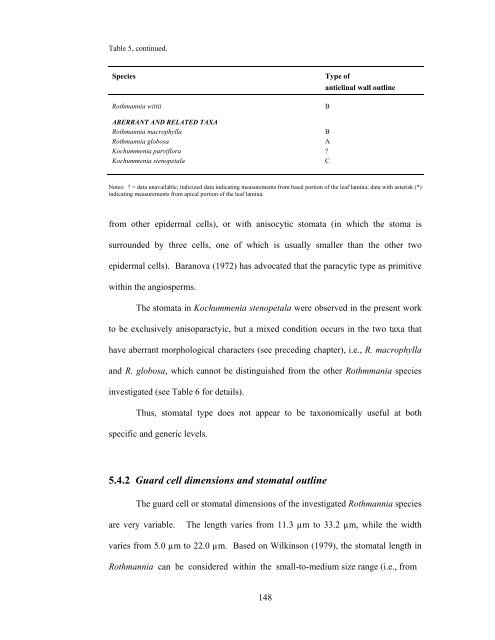Chapter 5.pdf - DSpace@UM
Chapter 5.pdf - DSpace@UM
Chapter 5.pdf - DSpace@UM
Create successful ePaper yourself
Turn your PDF publications into a flip-book with our unique Google optimized e-Paper software.
Table 5, continued.SpeciesType ofanticlinal wall outlineRothmannia wittiiBABERRANT AND RELATED TAXARothmannia macrophyllaBRothmannia globosaAKochummenia parviflora ?Kochummenia stenopetalaCNotes: ? = data unavailable; italicized data indicating measurements from basal portion of the leaf lamina; data with asterisk (*)indicating measurements from apical portion of the leaf lamina.from other epidermal cells), or with anisocytic stomata (in which the stoma issurrounded by three cells, one of which is usually smaller than the other twoepidermal cells). Baranova (1972) has advocated that the paracytic type as primitivewithin the angiosperms.The stomata in Kochummenia stenopetala were observed in the present workto be exclusively anisoparactyic, but a mixed condition occurs in the two taxa thathave aberrant morphological characters (see preceding chapter), i.e., R. macrophyllaand R. globosa, which cannot be distinguished from the other Rothmmania speciesinvestigated (see Table 6 for details).Thus, stomatal type does not appear to be taxonomically useful at bothspecific and generic levels.5.4.2 Guard cell dimensions and stomatal outlineThe guard cell or stomatal dimensions of the investigated Rothmannia speciesare very variable.The length varies from 11.3 µm to 33.2 µm, while the widthvaries from 5.0 µm to 22.0 µm. Based on Wilkinson (1979), the stomatal length inRothmannia can be considered within the small-to-medium size range (i.e., from148
















